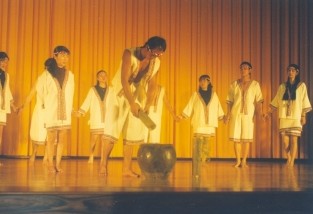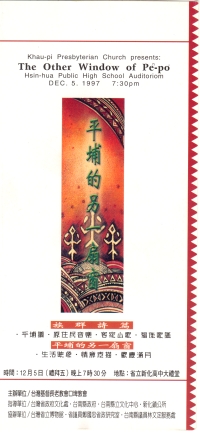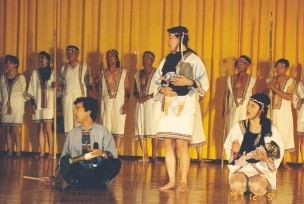| Open
your mind for a different view....
I. The Other Window of Pepo
1. How It Gets Started
In 1997, the Kou-pi Church rendered a performance entitled The
Other Window of Pepo at the assembly hall in Sin Hua Senior High
School.
|
Way before the foundation of
Siraya Culture Association, people concerned about the development
of aboriginal culture had something in mind: they were always
stunned to watch the dancing and chanting ceremony of Taiwanese
aborigines; however, in Taiwan, there is little connection
between Christianity and the native culture. |
|
Thus in the July of 1997, the Kou-pi Church came to an agreement
to present the Christmas Festival to share good tidings with neighbors
and friends afar with warmth during the Christmas season in the
local town of Sin-hua. For two years, the Kou-pi Church had men
and women, young and old alike, devoted in rehearsals of The Other
Window of Pepo since August 1997. Through this show, the lost memory
would be recovered and the spirit of our ancient culture seems to
revive from the silent past.
2. Significance of the Totem
| Red, black, and white, the main colors
of Pepo are interwoven into splendid patterns, which stand for
the abundant resources of the land. The wavy streaks, inspired
by the misty hills in the inky night, symbolize the hills where
the Pepo tribe settled down after their tiring migration. Additionally,
the black lines denote the connecting of the hearts of silent
insistence, resembling the rolling hills and the seeds that
fall onto the grounds and take roots to connect with each other.
Red geometry represents life, tear, and thrill, which are
joined together to be the warm connection of their hearts.
The sandy background color that is sprayed and painted as
red rain leads people to search for the rainbow of hope, a
commitment made by God of his own will with the land. The
pattern of half-men and half-trees that are placed in the
misty hills, is taken from the Pepo clothing embroidery. |
|
The dejected people raised arms toward the sharp, flaming eyes,
prayed sincerely and resolutely. The plural form of three people
in that pattern means that the Pepo will ennoble their lives as
a group for the future.
3. The Activity
The first half, The Poetry of the
Tribes, presents music from the Fus, the Hukas, and the Bu-Noh.
The second half The Other Window of Pepo is divided into three
parts: the representation of the tribal scenes, the impression
of their life, and the celebration for the full moon. Pepo tribal's
free and innocent lifestyle can be seen in the show via praying
for rain, playing games, holding hands, rearing babies, husking
rice, farming, plucking vegetables, drawing water, shouldering
firewood, hunting, and drinking at a party.
|
|
The scene of Rearing Babies |
|
Several instruments are used in the show, including the Nose Flute,
the Jews-Harp, and the Blowing Tube. About
the Musical Instruments
4.About the Music
| 1.Ta Li Bun Bun |
Pepo Melody |
 exact
lyrics exact
lyrics 
|


